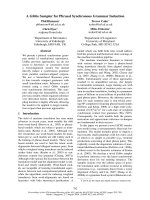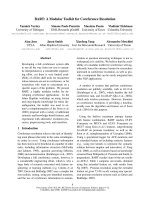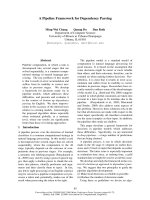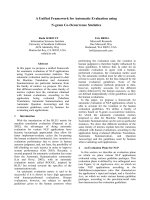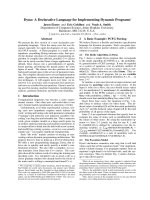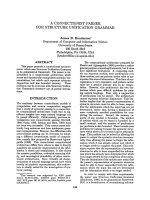Báo cáo khoa hoc:" A repetitive probe for FISH analysis of bovine interphase nuclei" doc
Bạn đang xem bản rút gọn của tài liệu. Xem và tải ngay bản đầy đủ của tài liệu tại đây (240.31 KB, 9 trang )
Genet. Sel. Evol. 32 (2000) 217–225 217
c
INRA, EDP Sciences
Original article
A repetitive probe for FISH
analysis of bovine interphase nuclei
Wafa SLIMANE
a,b
, Daniel VAIMAN
c
, Sophie GODARD
c
,
Anne V
AIMAN
c
, Edmond CRIBIU
c
, Jean-Paul RENARD
a∗
a
Unit´e biologie du d´eveloppement, Institut national de la recherche agronomique,
78352 Jouy-en-Josas Cedex, France
b
Services techniques de l’Union national des coop´eratives d’´elevage et
d’ins´emination artificielle, 13, rue Jou¨et, BP 65, 94703 Maisons-Alfort, France
c
G´en´etique biochimique et cytog´en´etique, Institut national de la recherche
agronomique, 78352 Jouy-en-Josas Cedex France
(Received 22 June 1999; accepted 20 December 1999)
Abstract – The purpose of this study was to generate repetitive DNA sequence
probes for the analysis of interphase nuclei by fluorescent in situ hybridisation
(FISH). Such probes are useful for the diagnosis of chromosomal abnormalities in
bovine preimplanted embryos. Of the seven probes (E1A, E4A, Ba, H1A, W18, W22,
W5) that were generated and partially sequenced, five corresponded to previously
described Bos taurus repetitive DNA (E1A, E4A, Ba, W18, W5), one probe (W22)
shared no homology with other DNA sequences and one (H1A) displayed a significant
homology with Rattus norvegicus mRNA for secretin receptor transmembrane domain
3. Fluorescent in situ hybridisation was performed on metaphase bovine fibroblast
cells and showed that five of the seven probes hybridised most centromeres (E1A,
E4A, Ba, W18, W22), one labelled the arms of all chromosomes (W5) and the H1A
probe was specific to three chromosomes (ch14, ch20, and ch25). Moreover, FISH with
H1A resulted in interpretable signals on interphase nuclei in 88% of the cases, while
the other probes yielded only dispersed overlapping signals.
satellite DNA / FISH / bovine / centromere
R´esum´e–G´en´eration d’une sonde bovine `as´equences r´ep´et´ees pour l’analyse
en FISH des noyaux bovins en interphase.
L’objectif de cette ´etude est d’isoler des
sondes nucl´eiques bovines sp´ecifiques d’un faible nombre de chromosomes permettant
une analyse par hybridation in situ fluorescente (FISH) des noyaux en interphase. De
telles sondes pr´esentent un outil pr´ecieux pour l’´etude d’anomalies chromosomiques
d’embryons chez les bovins. Sept sondes ont ´et´eg´en´er´ees (E1A, E4A, Ba, H1A,
W18, W22, W5) et partiellement s´equenc´ees : cinq d’entre elles correspondent `a des
s´equences r´ep´et´ees d’ADN g´enomique bovin d´ej`ad´ecrites (E1A, E4A, Ba, W18, W5),
∗
Correspondence and reprints
E-mail:
218 W. Slimane et al.
la sonde W22 ne pr´esente `a ce jour aucune homologie avec les s´equences connues
dans “Genbank” et la derni`ere, H1A (3,5 kb isol´ee apr`es digestion par l’enzyme
HindIII) pr´esente une homologie significative sur 158 paires de base avec l’ARNm
codant pour le 3
e
domaine transmembranaire du r´ecepteur de la secr´etine de rat
(Rattus norvegicus). L’hybridation in situ fluorescente sur des fibroblastes bovins en
m´etaphase a montr´e que cinq sondes (E1A, E4A, Ba, W18, W22) hybrident la plupart
des centrom`eres, que la sonde W5 marque les bras de tous les chromosomes, et que
la sonde H1A est sp´ecifique de trois chromosomes bovins (ch14, ch20 et ch25). De
plus, sur noyaux interphasiques, l’utilisation de H1A a permis d’obtenir des signaux
interpr´etables dans 88 % des cas, contrairement aux autres sondes qui donnent des
signaux superpos´es difficiles `a interpr´eter.
ADN satellite / FISH / bovin / centrom`ere
1. INTRODUCTION
Highly repetitive DNA represents a large fraction of most eukaryotic
genomes. In mammals, these DNA components are either dispersed through-
out the genome or arranged in tandem in large blocks known as satellite DNA
[4, 31], which often localise to pericentromeric areas. Probes containing such
sequences are considered as powerful tools for detecting numerical chromosome
abnormalities in eukaryotic cells [14]. After fluorescent in situ hybridisation
(FISH), they display distinct bright signals in metaphase as well as interphase
cells [11, 25]. These probes are now routinely used in human clinical cytogenet-
ics for various applications such as studying cellular disorders associated with
tumoral cells [1, 24], or genetic aberrations in tumours by analysing a single
cell suspension isolated from solid cancer. Thus, this method avoids cell culture
that may lead to selective growth of cells with the highest mitotic index [26].
FISH using repetitive probes has also been successfully applied for prenatal
diagnosis by analysing uncultured amniotic fluid samples as well as for human
preimplantation embryo diagnosis [15, 16, 23]. Recently, the use of repetitive
probes enabled preconception diagnosis by FISH analysis of both human
oocytes [23, 35] and spermatozoa [25, 32].
In the bovine species, very few repetitive DNA probes are available [33].
This is partly due to the fact that, in animal research programmes, FISH
is mainly used for physical genome mapping which involves unique sequence
probes to localise genes or genetic markers on metaphase plates [5, 30]. However,
in interphase nuclei, FISH using such probes does not allow accurate screening,
as signals are usually very weak and may be confused with the background.
With the recent advances in biotechnology associated with embryo transfer
in cattle, the study of genetic disorders in preimplantation embryos is becoming
highly relevant. Until now, chromosomal abnormalities in bovine embryos have
mainly been studied by karyotyping. Whole embryos incubated overnight in
colchicine [18, 20], have yielded very variable estimates of the aberrations. For
example, the incidence of chromosomal abnormalities in 2-cell bovine embryos
has been estimated at 12% by Iwasaki and Nakahara [17] and at 36% by Iwasaki
et al. [18]. In the same way, results on karyotypes at the blastocyst stage differ
according to studies. The main category observed is mixoploidy, which varies
between 44% [18] and 99% [9]. This variability is mainly due to the fact that
only a minor proportion of embryonic cells can be analysed. Our study aims
FISH in bovine interphase nuclei 219
to generate repetitive bovine DNA probes for the screening of chromosomal
abnormalities. In this work, we isolated and cloned seven repetitive probes,
one of which hybridised to a limited number of chromosomes. This probe
represents a promising tool for characterising the genetic status of interphase
nuclei, particularly for diagnosing embryos deriving from transgenesis or cloning
biotechnologies.
2. MATERIALS AND METHODS
2.1. Probes generation
Bovine genomic DNA was prepared according to Jeanpierre [19], and was
digested in six independent reactions by one of six different restriction en-
donucleases (BamH1, SacI, StuI, EcoRI, EcoRV and HindIII). After digestion,
restricted genomic DNA was run on 1% agarose gel in 1XTBE buffer overnight
at 60 V and stained with ethidium bromide. Prominent bands corresponding
to repetitive DNA elements were cut out from the gel, extracted, and purified
by the deep freeze / phenol technique [34]. Purified bands were ligated into
pGEM4Z (Promega) (pre-disgested with restriction enzymes yielding compat-
ible ends and dephosphorylated) in 20 µL total volume at 16
◦
C overnight.
One µL of ligation was electroporated into 20 µL home-made DH10B electro
competent cells grown in 3 mL of LB.
White colonies which likely corresponded to positive transformants contain-
ing the ligated band were selected after plating the transformation product on
LB plates with Ampicilline (100 µg·mL
−1
). DNA was extracted from the pos-
itive colonies, digested with the same enzyme used for plasmid digestion, and
electrophoresed on a 1% agarose gel to check that the insert was cloned. This
was done by ascertaining that the molecular weight of the band was the same
as that of the DNA fragment in the ligation product.
Roughly 500 bp of each probe were sequenced from one strand using a
universal primer vector. The DNA sequences obtained were compared with
Genbank/EMBL using the Blast program.
2.2. Probes labelling
Probes were labelled with biotin 16-dUTP (Boehringer Mannheim, Ger-
many) using a nick translation kit (GIBCO - BRL). Usually, 200 ng of DNA
were labelled in a 50 µL mixture containing (1) 0.2 mM each of dATP, dCTP,
dGTP, (2) 0.35 mM biotin 16-dUTP, (3) 2.5 U DNA polymerase I, (4) 2 mU
DNAse I.
Labelled DNA samples were ethanol precipitated in the presence of soni-
cated salmon sperm DNA (100 µg). Precipitates were dissolved in 20 µLof
hybridisation mixture {60% formamide (Sigma) in SSP (Saline Sodium Phos-
phate) and 10% dextran sulfate (Pharmacia)} at 37
◦
C, approximately 30 min
prior to denaturation (6 min at boiling temperature) and chilled rapidly on ice.
2.3. In situ hybridisation (ISH)
In situ hybridisation was performed on bovine fibroblasts from a cell line
available in the laboratory (59 XX, t4.10). Subsequently, a normal 60XX cell
220 W. Slimane et al.
line was used to validate the results. After BrdU incorporation during the
late S phase, air-dried chromosomal preparations were obtained using stan-
dard procedures [7]. Protocols used for FISH were as previously described in
Bahri-Darwich et al. [2]. Chromosomal DNA was counterstained and R-banded
by the direct fluorescent technique described by Lemieux et al. [21]. The slides
were screened with a Leica fluorescence microscope and photomicrographs were
taken with a Fujichrome 400 Asa colour slide film.
Chromosome identification was performed according to the Texas nomen-
clature [27]. FISH experiments were carried out with the seven probes and the
specificity of each probe was determined on both metaphase and interphase
bovine fibroblasts. Each probe was used in five independent experiments, each
of which involved scoring 50 interphase and 10 metaphase cells from the 59
XX, t4.10 cell line. In addition, each probe was subsequently hybridised on the
60XX cell line.
3. RESULTS
After digestion of genomic DNA samples by six different enzymes, 11
prominent bands ranging from 0.8 to 3.5 kb were clearly identified. Seven
out of the 11 bands were cloned. DNA sequence analysis revealed 90 - 95%
identity with Bos taurus repetitive sequences (satellite or SINE) for five of the
seven probes. One probe (AF124263) revealed no homology with previously
described DNA sequences, and another one (AF118556) derived from the 3.5
kb HindIII fragment, displayed 90% identity with a Rattus norvegicus secretin
receptor transmembrane domain 3 from which 158 bp out of 500 were sequenced
(Tab. I).
After FISH, all these probes gave clear fluorescent signals in fibroblast
metaphases derived from the 59 XX, t4.10 as well as the 60XX cell lines.
Each one consisted of a set of small clustered spots producing a bright distinct
signal. The W5 probe, which corresponded to the SINE sequence, hybridised
to all chromosomes from each metaphase, and painted the entire arms of
chromosomes except for the centromeres (Fig. 1a); five other probes hybridised
to a large number of centromeres (Fig. 1b), and appeared to be specific for
about 25 of the 30 pairs of chromosomes. The last probe (H1A) hybridised
to subcentromeric regions of only three chromosomes and provided six strong
signals which where clearly identified on all the metaphases analysed (Fig. 1c
and 1d).
FISH in interphase fibroblast nuclei showed that all probes except H1A
yielded overlapping signals which were widely dispersed through the optical
section of the nuclei, making an accurate count impossible (Fig. 2a). In contrast,
six fluorescent signals (Fig. 2b) could be clearly counted in 70% (175/250) of the
nuclei when hybridised with the H1A clone. Carefull screening of labelled nuclei
made it possible to identify 10% (25/250) nuclei with three spots (haploid) and
8% (20/250) nuclei with 12 signals (hyperploid). Some cells (12%; 30/250) could
not be scored because of intermingling signals.
FISH in bovine interphase nuclei 221
Table I. Probe sequence analysis.
Probes Homologous to
∗
Localisation
E1A (EcoRI) Bovine 1.715 satellite Most centromeres
(embV00124)
∗
E4A (EcoRI) Bos taurus microsatellite Most centromeres
DVEPCO46 (gb/U95979)
Ba (BamH1) Bovine genomic fragment for Most centromeres
1.709 satellite DNA
(emb/X00979)
H1A (HindIII) Rattus norvegicus mRNA for Subcentromeric regions of
secretin receptor chromosomes 14, 20, 25
(emb/X59132)
W18 (SacI) Bovine satellite DNA Most centromeres
fragment(emb/VOO122)
W22 (EcoRV) No homology Most centromeres
W5 (Stu1) Bos taurus DNA for SINE All chromatids
sequence Bov-1D
(emb/X64126)
* Figures in brackets indicate accession numbers with EMBL/GenBank data base.
4. DISCUSSION
In genomic cytogenetic mapping studies, the objective is to locate a given
genomic sequence in a specific chromosomal region; therefore, the most suitable
probes are those derived from a unique sequence [30]. Conversely, it has been
demonstrated that probes containing centromeric repetitive sequences are the
most adequate for detecting numerical aberrations in interphase nuclei [8, 10,
28, 37]. In humans, repetitive sequence probes specific for each chromosome are
now commercially available [14], whereas bovine chromosome specific probes
come mainly from cosmid and YAC/BAC libraries and are only recently
available in a few laboratories [5, 12, 13, 22, 30].
The approach used in this study made it possible to isolate a probe (H1A)
suitable for analysing interphase nuclei. Using this probe, abnormal plo¨ıdies
were detected in interphase nuclei where 8% and 10% of cells yielded more or
less than six signals, respectively. Since no abnormal numbers were detected in
metaphases, these discrepancies could stem from the fact that we scored only
complete metaphases, incomplete ones being discarded to avoid confusion with
a hypotonic treatment artefact. The abnormal numbers observed on interphase
nuclei could correspond to hyper- and hypoploid nuclei respectively, and be
attributed to the cell line used [6]. However, a hybridisation artefact which
may be due to superimposition of signals when two labelled chromosomes lie
immediately adjacent or on top of each other, should not be disregarded [11].
222 W. Slimane et al.
Figure 1. Signals obtained following hybridisation on metaphase cells.
a. A 59XXt4.10 cell line hybridised with the W5 probe.
b. A 59XXt4.10 cell line hybridised with the E1A probe.
c. A 59XXt4.10 cell line hybridised with the H1A probe.
d. A normal 60XX cell line hybridised with the H1A probe.
Apart from these limitations, the H1A probe offers the advantage of hybri-
dising to three chromosome pairs simultaneously. It thus provides an accurate
assessment of aneuploidies in interphase nuclei, since it discriminates between
monosomy for a single chromosome and complete haploidy.
In conclusion, our work has enabled us to isolate a probe specific to a lim-
ited number of chromosomes. Increasing the number of restriction enzymes for
a more complete digestion of genomic DNA would probably generate a panel
of new probes which could be used for routine detection of numerical chro-
mosome abnormalities in cattle cells. Alternatively, the isolation of sequences
specific to chromosome fragments or whole chromosome painting probes by
microdissection might be the method of choice to generate a complete set of
chromosome specific probes. The feasibility of such an approach is widely re-
ported in humans [3, 29, 36]. These probes would constitute promising tools
for analysing the chromosomes of embryonic cells which are now widely used
in biotechnology.
FISH in bovine interphase nuclei 223
Figure 2. Signals obtained following hybridisation on interphase nuclei.
a. A 59XXt4.10 cell line hybridised with the Ba probe.
b. A 59XXt4.10 cell line hybridised with the H1A probe.
ACKNOWLEDGEMENTS
We thank Dr H. Hayes and Dr I. Hue for helpful discussions. This work was
partly supported by a grant from the European contract CT950190. W. Slimane
is the recipient of a fellowship from INRA. We also thank A.M. Wall for revising
the manuscript.
REFERENCES
[1] Afify A., Mark H.F., Trisomy 8 in embryonal rhabdomyosarcoma detected
by FISH, Cancer Genet. Cytogenet. 108 (1999) 127–132.
[2] Bahri-Darwich I., Vaiman D., Olsaker I., Oustry A., Cribiu E.P., Assignment
of bovine synteny groups U27 and U8 to R-banded chromosome 12 and 27, respec-
tively, Hereditas 120 (1994) 261–265.
[3] Bolzer A., Craig J.M., Cremer T., Speicher M.R., A complete set of repeat-
depleted, PCR-amplifiable, human chromosome-specific painting probes, Cytogenet.
Cell Genet. 84 (1999) 233–240.
[4] Brutlag D.L., Molecular arrangement and evolution of heterochromatic DNA,
Annu. Rev. Genet. 14 (1980) 121–144.
[5] Cai L., Taylor J. F., Wing R.A., Gallagher D.S., Woo S.S., Davis S.K.,
Construction and characterization of a bovine bacterial artifical chromosome library,
Genomics 29 (1995) 413–425.
[6] Cribiu E.P., Popescu C.P., L’aneuplo¨ıdie et la polyplo¨ıdie chez les bovins dans
les cultures de cellules bovines, Ann. G´en´et. S´el. Anim. 9 (1977) 275–282.
224 W. Slimane et al.
[7] Cribiu E.P., Matejka M., Darre R., Durand V., Berland H.M., Bouvet A.,
Identification of chromosomes involved in a Robertsonian translocation in cattle,
Genet. Sel. Evol. 21 (1989) 555–560.
[8] de Sario A., Vagnarelli P., De Carli L., Aneuploidy assay on diethylstilbestrol
by means of in situ hybridization of radioactive and biotinylated DNA probes on
interphase nuclei, Mutat. Res. 243 (1990) 249–253.
[9] Dorland M., Duijndam W.A.L., Kruip Th.A.M., Donk J.A. van der, Cytoge-
netic analysis of day-7 bovine embryos by cytophotometric DNA measurements, J.
Reprod. Fertil. 99 (1993) 681–688.
[10] Eastmond DA., Pinkel D., Detection of aneuploidy and aneuploidy-inducing
agents in human lymphocytes using fluorescence in situ hybridization with chromo-
some specific DNA probes, Mutat. Res. 234 (1990) 303–318.
[11] Eastmond D.A., Rupa D.S., Hasegawa L.S., Detection of hyperdiploidy and
chromosome breakage in interphase human lymphocytes following exposure to the
benzene metabolite hydroquinone using multicolor fluorescence in situ hybridization
with DNA probes, Mutat. Res. 322 (1994) 9–20.
[12] Eggen A., Solinas T.S., Fries R.A., Cosmid specific for sequences encoding
a microtubule associated protein, MAPIB, contains a polymorphic microsatellite and
maps to bovine chromosome 20q14, J. Hered. 89 (1998) 359–363.
[13] Godard S., Schibler L., Oustry A., Cribiu E.P., Gu´erin G., Construction of
a horse BAC library and cytogenetical assignment of 20 type I and type II markers,
Mamm. Genome 9 (1998) 637-638.
[14] Gole L.A., Bongso A., Fluorescent in-situ hybridization - Some of its appli-
cations in clinical cytogenetics, Singapore Med. J. 38 (1997) 497–503.
[15] Griffin D.K., Handyside A.H., Harper J.C., Wilton L.J., Atkinson G., Sous-
si I., Wells D., Kontogianni E., Tarin J., Geber S., Asangla A.O., Winston R.M.L.,
Delhanty J.D.A., Clinical experience with preimplantation diagnosis of sex by dual
FISH, J. Assist. Reprod. Genet. 11 (1994) 132–142.
[16] Handyside A.M., Delhanty J.D.A., Cleavage stage biopsy of human embryos
and diagnosis of X-linked recessive disease, in: Edwards R.G. (Ed.), Preimplantation
Diagnosis of Human Genetic Disease, University Press, Cambridge, 1993, pp.239–270.
[17] Iwasaki S., Nakahara T., Incidence of embryos with chromosomal anomalies
in the inner cell mass among bovine blastocysts fertilized in vitro, Theriogenology 34
(1990) 83–690.
[18] Iwasaki S., Hamano S., Kuwayama M., Yamashita M., Ushijima H., Na-
gaoka S., Nakahara T., Developmental changes in the incidence of chromosome ab-
normalities of bovine embryos fertilized in vitro, J. Exp. Zool. 216 (1992) 79–85.
[19] Jeanpierre M., A rapid method for the purification of DNA from blood,
Nucleic Acids Res. 15 (1987) 9611.
[20] Kawarsky S.J., Basrur P.K., Stubbings R.B., Hansen P.J., King A.W., Chro-
mosomal abnormalities in bovine embryos and their influence on development, Biol.
Reprod. 54 (1996) 53–59.
[21] Lemieux N., Dutrillaux B., Viegas-Pequignot E., A simple method for simul-
taneous R- or G-banding and fluorescence in situ hybridization of small single-copy
genes, Cytogenet. Cell Genet. 59 (1992) 311–312.
[22] Libert F., Lefort A., Okimoto R., Womack J., Georges M., Construction of
a bovine genomic library of large yeast artificial chromosome clones, Genomics 18
(1993) 270–276.
[23] Munn´e S., Khalid M., Sultan M., Heinz-Ulrich Weier M.D., Assessment of
numeric abnormalities of X, Y, 18, and 16 chromosomes in preimplantation human
embryos before transfer, Am. J. Obstet. Gynecol. 172 (1995) 1191–1201.
[24] Onodera N., Nakahata T., Tanaka H., Ito R., Honda T., Trisomy 6 in a
childhood acute mixed lineage leukemia, Acta. Paediatr. Jpn. 40 (1998) 616–620.
FISH in bovine interphase nuclei 225
[25] Pellestor F., Quenesson I., Coignet L., Girardet A., Andr´eo B., Lefort G.,
Charlieu J.P., FISH and PRINS, a strategy for rapid chromosome screening: appli-
cation to the assessment of aneuploidy in human sperm, Cytogenet. Cell Genet. 72
(1996) 34–36.
[26] Poddighe P.J., Moesker O., Smeets D., Awwad B.H., Ramaekers F.C.S.,
Interphase cytogenetics of hematological cancer: comparison of classical karyotyping
and in situ hybridization using a panel of eleven chromosome specific DNA probes,
Cancer Res. 51 (1991) 1959–1967.
[27] Popescu C.P., Long S., Riffs P., Womack J., Schmutz S., Fries R., Gal-
lagher D.S., Standardization of cattle karyotype nomenclature: report of the com-
mittee for the standardization of the cattle karyotype, Cytogenet. Cell Genet. 74
(1996) 259–261.
[28] Raimondi E., Scariolo S., De Sario A., De Carli L., Aneuploidy assays on
interphase nuclei by means of in situ hybridization with DNA probes, Mutagenesis 4
(1989) 165–169.
[29] Schermelleh L., Thalhammer S., Heckl W., Posl H., Cremer T., Schutze K.,
Cremer M., Laser microdissection and laser pressure catapulting for the generation
of chromosome-specific paint probes, Biotechniques 27 (1999) 362–367.
[30] Schibler L., Vaiman D., Oustry A., Giraud-Delville C., Cribiu E.P., Com-
parative gene mapping: a fine-scale survey of chromosome rearrangements between
ruminants and humans, Genome Res. 8 (1998) 901–915.
[31] Singer M., Highly repeated sequences in mammalian genomes, Int. Rev.
Cytol. 76 (1982) 67–112.
[32] Spriggs E.L., Rademaker A.W., Martin R.H., Aneuploidy in human sperm:
the use of multicolor FISH to test various theories of non-disjunction, Am. J. Hum.
Genet. 55 (1996) 356–362.
[33] Solinas-Toldo S., Mezzelani A., Hawkins G.A., Bishop M.D., Olsaker I.,
Mackinlay A., Ferretti L., Fries R., Combined Q-banding and fluorescence in situ
hybridization for the identification of bovine chromosome 1 to 7, Cytogenet. Cell
Genet. 69 (1995) 1–6.
[34] Vaiman D., R´egulation par les interf´erons de la transcription des formes de
poids mol´eculaires 40 et 46 Kda de la 2’-5’ oligo-A synth´etase, Doctorat de G´en´etique
humaine de l’Universit´e Paris VII, 1991, 167 p
[35] Verlinsky Y., Cieslak J., Freidine M., Luakhnentko V., Wolf G., Kovalin-
skaya L., White M., Lifchez A., Kaplan B., MoiseJ Valle J., Ginsberg N., Strom C.,
Kuliev A., Pregnancies following preconception diagnosis of common aneuploidies by
FISH, Human Reprod. 10 (1995) 1923–1927.
[36] Weimer J., Kiechle M., Senger G., Wiedemann U., Ovens-Raeder A., Schui-
erer S., Kautza M., Siebert R., Arnold N., An easy and reliable procedure of mi-
crodissection technique for the analysis of chromosomal breakpoints and marker chro-
mosomes, Chromosome Res. 7 (1999) 355–362.
[37] Zhao L., Khan Z., Hayes K.J., Glassman A.B., Interphase fluorescence in
situ hybridization analysis: A study using centromeric probes 7, 8, and 12, Ann. Clin.
Lab. Sci. 28 (1998) 51–56.


